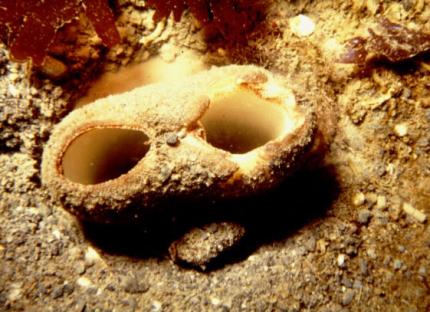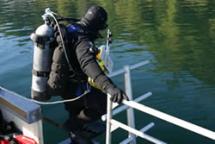
Commercial geoduck clam harvest is managed by the Washington Department of Natural Resources. The Washington Department of Fish and Wildlife (WDFW) is responsible for biological management and enforcement of WDFW regulations of this valuable resource. A competitive bid process is used to sell harvest contracts to the highest responsible bidder. Successful bid divers are required to obtain a WDFW fishery license prior to commercial harvest.
https://wdfw.wa.gov/publications/00224
State geoduck harvest areas receive biological surveys by WDFW biologist/divers prior to commercial harvest. The surveys are used to determine the biomass, average geoduck density, average weight, and to characterize the habitat present. The harvest areas are called “tracts.”
For additional information on state geoduck harvest or for further biological information, contact Henry Carson at 360-902-2846 or Henry.Carson@dfw.wa.gov. For information on treaty tribe harvest, contact the tribes individually.
Find geoduck tracts
About geoduck tracts
All geoduck tracts are in marine subtidal areas between the -18 and -70 foot water depth contours (at the zero tide level, or mean lower low water). When eelgrass beds are present, geoduck tract nearshore boundaries may be deeper than -18 ft. (MLLW). Where Pacific herring habitat is present, geoduck harvest must be deeper than -25 ft. (MLLW) and deeper than -35 ft. (MLLW) during the herring spawning season. Geoduck tracts are found throughout Puget Sound on soft bottom substrates. There are no known tracts on the outer coastline of Washington.
History of the fishery

Annual subtidal scuba surveys, to estimate the abundance and distribution of the geoduck clam (Panopea generosa) resource, began in 1967 in Washington state. About 110 million pounds of geoducks, distributed throughout Puget Sound at water depths down to -60 feet (MLLW), were initially identified. In 1970, the Washington Legislature established a commercial geoduck clam fishery and designated the Washington Departments of Fisheries (Fisheries subsequently merged with the Dept. of Wildlife) and Natural Resources (DNR) to co-manage the fishery. WDFW is primarily responsible for biological management of the fishery and DNR is primarily responsible for harvest management. The year-round fishery generates revenue for the state (over 20 million, $US each year) through a competitive bid process and sale of the rights to harvest shares of the quota on discrete geoduck “tracts.” In 1985, a wild stock geoduck fishery Environmental Impact Statement (EIS) was completed. In 1994, the Stevens Treaty tribes affirmed their rights to harvest shellfish resources in common with the citizens of the state (50:50 sharing), commonly known as the Rafeedie Decision. The treaty tribes have fully participated in the commercial geoduck clam fishery since 1995.
In 1997, state and tribal co-managers adopted a deterministic age-structured equilibrium yield model for the geoduck fishery (Bradbury et al., 2000) and recommended an annual total allowable catch (TAC) rate of 2.7% of the commercially available geoduck biomass in seven management regions. More recently, WDFW, WDNR, and treaty tribes have developed a new planning tool to balance the harvest rate with the observed rate of tract recovery. Now that the fishery is over 50 years old, the increase in geoduck density after harvest has been estimated for over 70 tracts. In several areas, co-managers have reduced the annual catch to improve sustainability.
In 2001, the wild commercial geoduck fishery EIS was updated and a Final Supplemental EIS was completed. In 2008, a federal Habitat Conservation Plan was completed for the wild geoduck fishery. Both of these documents can be found at the Department of Natural Resources website. State Environmental Policy Act (SEPA) Environmental Assessments are completed for state harvest areas and are part of SEPA compliance for state harvest auctions.
Health status of harvest areas
Geoduck tracts are only open to harvest when they are safe for human consumption. Tracts are classified by the Washington Department of Health, and area classifications can be viewed at the DOH Office of Shellfish and Water Protection . Biotoxin and arsenic testing are also done on a regular basis to determine if geoduck tracts can continue to be harvested.
Frequently asked questions
How long can geoducks live?
Geoducks are long-lived, with one sample in Washington aged at 173 years old, and one in B.C. aged at 179 years old. The average for geoducks, in unfished areas, is 46 years old.
What about illegal harvest?
The high value and wide distribution of geoducks increases the risk of illegal harvest. It is important for those who suspect illegal harvest to immediately contact WDFW Enforcement with identification information for the harvest vessel and participants. Do not attempt to directly contact someone who is illegally harvesting.
How do geoducks reproduce?
Geoducks are broadcast spawners (into the water column), and spawning is often observed to be synchronous, meaning the males and females “release” at the same time. Fecundity (number of eggs) is reported as high as 10 million eggs per year per spawner. Geoducks are known to be “trickle spawners”, releasing gametes over a season which begins in spring and peaks in June and July in Washington. When eggs are fertilized, they metamorph into larvae which may be floating in the water for 3-5 weeks before settling and digging into the substrate.
Where are geoducks found?
Geoducks are distributed throughout Puget Sound in soft substrates (including mud, sand, sand), and are abundant in South/Central Puget Sound and northern Hood Canal. The vertical distribution of geoducks is from the low intertidal zone (+1.0 feet) to -300 feet (~100 meters of water depth)
How do geoducks grow?
Growth varies from area to area, depending upon substrate depth and environmental conditions. Growth (measured as shell length) is generally rapid from years 0-15 and then the rate slows and the shell thickness increases. Average shell lengths range from 12.0 cm (Dallas Bank) to 16.8 cm (Fishermans Point).
How large can geoducks become?
The maximum geoduck weight measured in Washington state from a WDFW survey sample was 3700 grams or 8.16 pounds (Adelma Beach, 11/8/2000). The Puget Sound average geoduck weight from survey samples is 1100 grams or 2.42 pounds.
How is this wild stock geoduck fishery managed for sustainability?
An important tool for biological management of this fishery is development of a sustainable harvest rate (see above). Another cornerstone of responsible management is to survey commercial geoduck tracts to obtain estimates of biomass. Discrete geoduck “tracts” are sampled for geoduck density and weight, to estimate pre-fishing biomass prior to harvest. Following harvest, tracts are re-surveyed to corroborate harvest reported on fish tickets and to establish a post-fishing biomass estimate. Accurate catch accounting is also important for fishery management. The DNR harvest monitoring program assures harvest occurs within designated tract and that harvest is accurately reported.
How are other species protected during geoduck harvest?
To minimize impacts to benthic species, selective harvest gear is used (water jet) during commercial tract harvest, and geoducks are individually harvested. Sensitive spawning, nursery, and migratory habitat of other important marine species (including forage fish, crab, and salmon) are identified and excluded from geoduck harvest areas.
Rules and regulations
- WAC 220-340-300: Commercial geoduck harvest—Gear restrictions.
- WAC 220-340-310: Commercial geoduck harvest license.
- WAC 220-340-320: Commercial geoduck harvest—Requirements and unlawful acts.
- WAC 220-340-330: Commercial geoduck harvest—Time and area restrictions.
- WAC 220-340-070: Commercial geoduck harvest—Geoduck diver license application and issuance process.
- WAC 220-340-020: Shellfish—Unlawful acts—Commercial.
Geoduck aquaculture
What are the differences between the wildstock geoduck clam fishery and commercial geoduck aquaculture in Washington?
The Washington state wildstock geoduck fishery is co-managed by WDFW and DNR, and is coordinated with the Washington Treaty Tribes, who have established geoduck harvest rights. The wildstock geoduck fishery is managed for harvest based on natural production, and artificial enhancement is not part of wildstock management plans. The bedlands where geoducks are harvested in the wildstock fishery are owned and managed by DNR for public benefit. The wild geoduck harvest areas (termed tracts) are assessed, fished to a pre-determined level, and are then closed to harvest until the geoduck density has recovered to a pre-fishing level. The harvested areas are allowed to recover through natural processes and recruitment of wild geoducks.
Commercial geoduck clam aquaculture occurs on privately-held or leased lands, and to date has been mostly in intertidal areas (on beaches). A WDFW Aquatic Farm Registration (PDF) and Washington Department of Health (DOH) shellfish license are required to cultivate and sell farm-raised geoducks. Import or transfer of shellfish (including geoducks) into Washington waters may require a shellfish import or shellfish transfer permit to control the spread of shellfish diseases and pests. The aquatic farmer uses hatchery-raised geoducks for propagation and typically plants geoduck “seed” at a higher density than what occurs in nature. The aquatic farmer does not rely on natural geoduck settlement to grow a standing stock. It is common for an aquatic farmer to use predator protection devices (pvc tubes or netting) around small geoduck “seed” when they are most vulnerable to predation by shrimp, crabs, flatfish, and sea stars (in the first six to 18 months after planting). A crop of geoducks may take 6-8 years to reach market size. After harvest, an intertidal area under an aquatic farmers control may be re-planted with geoduck seed to begin a new crop.